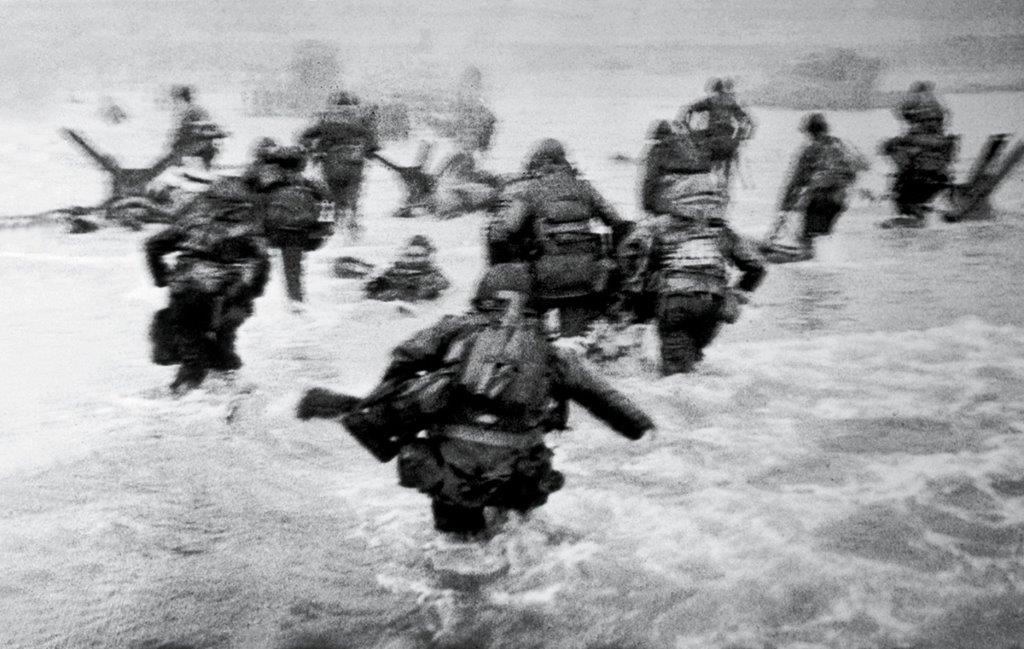The Magnificent Eleven, 1944

This photograph by Robert Capa (1913-1954) is one of the most totemic images from the front lines of World War Two.
The orders Capa received from the United States Army in the last days of May, 1944 stated ‘You are not to leave your apartment for more than an hour at a time. Your equipment must be packed’. As one of only four photographers chosen to cover the mass assault on Hitler’s Europe, this left him just enough time to rush out to buy a Burberry coat and Dunhill silver flask. Capa always liked to cut a dashingly suave figure.
It is one in a group of photos taken by Capa when he was with the first wave of troops who faced heavy resistance from the Germans. Despite being under constant fire, Capa still managed to take a comprehensive 106 pictures. Only 11 survived, providing the name for the collection – an accident at the Life magazine photo lab meant that the rest were lost.
Capa’s time on Omaha beach was not his first experience of war. He had already covered the Spanish Civil War and the Second Sino-Japanese War as a combat photographer and photojournalist. An account by one American soldier who is seen in the series described how involved Capa would really get; “I was surprised to see him there. I saw the press badge and thought ‘What the hell is he doing here?’ He helped me out of the water and then he took off down the beach to take more photos.” Embedded with the allied troops, as a Hungarian national he was the only ‘enemy alien’ who was given such access.
The 11 Capa photos were powerful enough to inspire Steven Spielberg’s terrifying beach landing scenes in one of the most shattering openings of all war films, Saving Private Ryan. The pictures had been printed in Lifemagazine,with captions accompanied some images explaining that they were slightly out of focus because Capa’s hands were shaking, in the terror and excitement of the moment. ‘Slightly Out of Focus’ would later be the title of his autobiographical account of the war.
After D-Day, Capa followed the Allied invasion of Nazi-occupied France, into Paris for its liberation. Here, he captured the cheering crowds to contrast them with the broken, captured German soldiers. Capa stuck with his preferred subject matter, documenting the Battle of the Bulge for V Day, and was later assigned to the conflicts during the first Arab-Israeli War and the First Indochina war.
As early as 1938 he had been described in Picture Post magazineas “The greatest war photographer in the world” with a spread of 26 pages of pictures Capa had taken during the Spanish Civil War. His picture of a combatant who had just been fatally wounded earned him his international reputation, and became one of the most powerful ever symbols of the tragedies of battle. ‘TheFalling Soldier’ was taken by Capa without him even looking through the camera viewfinder. It was the first picture to show the grim reality of real battlefield death.
Capa said in a 1947 radio interview that he “was in the trenches with Republican militiamen. The men would pop above ground to charge and fire old rifles at a machine gun manned by troops loyal to General Franco. Each time, the militiamen would get gunned down. During one charge, I held my camera above my head and clicked the shutter”. The result is an image that is filled with emphatic drama and movement as the shot soldier tumbles backward.
Born Andre Friedmann in Budapest, Capa’s hauntingly realistic images ‘taken from the trenches’ marked his approach. His motto throughout his career was ‘If your photographs aren’t good enough, you’re not close enough’. He recorded the truths of combat, but his own professional persona was somewhat of a fiction.
He had fled the Nazis and settled in Paris in 1943 where he adopted his school nickname, cápa, Hungarian for ‘shark’, and worked on sounding vaguely American, making it easier for him to sell his photos to Allied countries. His girlfriend and business partner capitalised on his chosen identity and marketed his photos as by the ‘great American photographer, Robert Capa’.
Although war was his most enduring subject, Capa did not spend all of his time taking photographs, dug in with the troops.
He grew close to a number of artists and writers throughout his career, including Ingrid Bergman, who became his lover, and John Steinbeck, who travelled with him to the Soviet Union in 1947.
He was also close to the great French photographer Henri-Cartier Bresson, with whom he had earlier shared a darkroom, and together they co-founded Magnum Photos in 1947, a cooperative agency which handled assignments for freelance photographers. Magnum developed a reputation of excellent photojournalism, with Capa was its formidable and popular president.
On 25 May 1954, he was photographing for Life magazine in Thai Binh, Indochina, when he stepped on a landmine and died instantly. The French Army awarded him the Croix de Guerre posthumously. The Robert Capa Gold Medal Award was established in 1955 to reward exceptional professional merit. In reality, Capa’s abiding legacy would be his tenacity and dedication to reveal the harrowing nature of the battlefield, and, of course, his remarkable bravery. But as he said “It is not enough to have talent. You also have to be Hungarian.”
